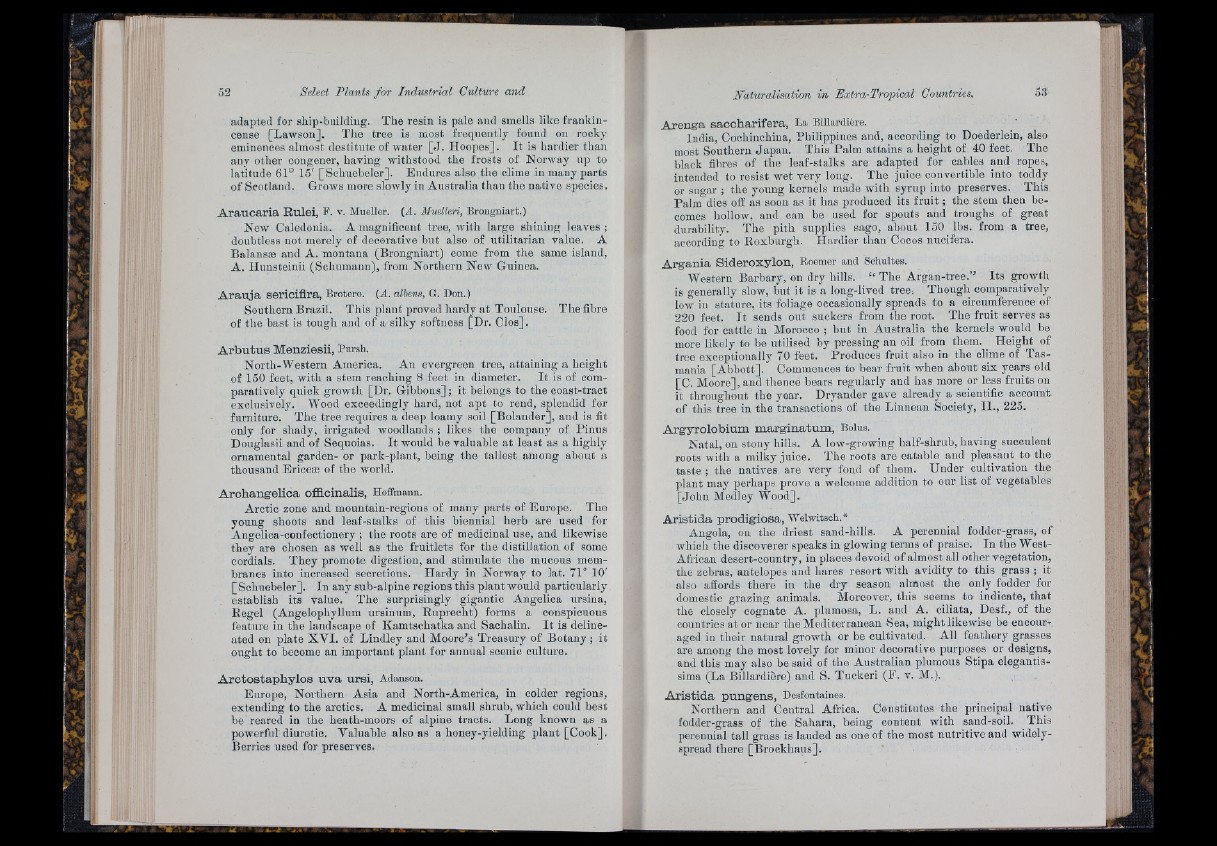
adapted for ship-building. The resin is pale and smells like frankincense
[Lawson]. The tree is most frequently found on rocky
eminences almost destitute of water [ J . Hoopes]. I t is hardier than
any other congener, having witlistood the frosts of Norway up to
latitude 61° 15' [Schuebeler]. Endures also the clime in many parts
of Scotland. Grows more slowly in Australia than the native species.
A r a u c a r ia Rulei, P. V. Mueller. (A. Muelleri, Brongniart.)
New Caledonia. A magnificent tree, with large shining leaves;
doubtless not merely of decorative but also of utilitarian value. A
Balanste and A. montana (Brongniart) come from the same island,
A. Himsteinii (Sclmmaim), from Northern New Guinea.
A r a u ja se ric iflra , Brotero. (A. albens, G. Don.)
Southern Brazil. This plant proved hardy a t Toulouse,
of the bast is tough and of a silky softness [Dr. Clos].
The fibre
A r b u tu s M en z ie sii, Pursh.
Nortli-Western America. An evergreen tree, attaining a height
of 150 feet, with a stem reaching 8 feet in diameter. I t is of comparatively
quick growth [Dr. Gibbons] ; it belongs to the coast-traot
exclusively. Wood exceedingly hard, not apt to rend, splendid for
furniture. The tree requires a deep loamy soil [Bolander], and is fit
only for shady, irrigated woodlands ; likes the company of Finns
Douglasii and of Sequoias. I t would be valuable a t least as a highly
ornamental garden- or park-plant, being the tallest among about a
thousand Erioese of the world.
A rc h a n g e lic a offlcina lis, Hoffmann.
Arctic zone and mountain-regions of many parts of Europe. The
young shoots and leaf-stalks of tliis biennial herb are used for
Angelica-confectionery ; the roots are of medicinal use, and likewise
they are chosen as well as the fruitlets for the distillation of some
cordials. They promote digestion, and stimulate the mucous membranes
into increased secretions. Hardy in Norway to lat. 71° 10'
[Schuebeler]. In any sub-alpine regions this plant would particularly
establish its value. The surprisingly gigantic Angelica ursina.
Regel (Angelophyllnm ursinnm, Rnprecht) forms a conspicuous
feature in the landscape of Kamtschatka and Sachalin. I t is delineated
on plate X V I. of Lindley and Moore’s Treasury of B o tan y ; it
ought to become an important plant for annual scenic culturCi
A r c to s ta p h y lo s u v a u rs i, Adanson.
Europe, Northern Asia and North-America, in colder regions,
extending to the arctics. A medicinal small shrub, which could best
be reared in the heath-moors of alpine tracts. Long known as a
powerful diuretic. Valuable also as a honey-yielding plant [Cook].
Berries used for preserves.
A re n g a s a o c h a r ife r a , La Biliardière.
India, Cochinchina, Fhilippines and, according to Doederlein, also
most Southern Japan. This Palm attains a height of 40 feet. The
black filtres of the leaf-stalks are adapted for cables and ropes,
intended to resist wet very long. The juice convertible into toddy
or sugar ; the young kernels made with syrup into preserves. This
Palm dies off as soon as it has produced its fruit ; the stem then becomes
hollow, and can be used for spouts and troughs of great
durability. The pith supplies sago, about 150 lbs. from a tree,
according to Roxburgh. Hardier than Cocos nucífera.
A rg a n ia S id e ro x y lo n , Roemer and Schultes.
Western Barbary, on dry hills. “ The Argan-tree.” Its growth
is generally slow, hut it is a long-lived tree, Though comparatively
low in stature, its foliage occasionally spreads to a circumference of
220 feet. I t sends out suckers from the root. The fruit serves as
food for cattle in Morocco ; but in Australia the kernels would be
more likely to be utilised by pressing an oil from them. Height of
tree exceptionally 70 feet. Produces fruit also in the clime of Tasmania
[Abbott]. Commences to bear fruit when about six years old
[C. Moore], and tlienoe bears regularly and has more or less fruits on
it throughout the year. Dryander gave already a scientific account
of this tree in the transactions of the Linnean Society, I I ., 225.
A rg y ro lo b ium m a rg in a tum , Bolus.
Natal, on stony hills. A low-growing half-shrub, having succulent
roots with a milky juice. The roots are eatable and pleasant to the
taste ; the natives are very fond of them. Under cultivation the
plant may perhaps prove a welcome addition to our list of vegetables
[John Medley Wood].
A ris tid a p ro d ig io s a , Welwitsch.*
Angola, on the driest sand-hills. A perennial fodder-grass, of
which the discoverer speaks in glowing terms of praise. In the West-
Affican desert-country, in places devoid of almost all other vegetation,
the zebras, antelopes and hares resort with avidity to this grass ; it
also affords there in the dry season almost the only fodder for
domestic grazing animals. Moreover, this seems to indicate, that
the closely cognate A. plumosa, L. and A. ciliata, Desf., of the
countries at or near the Mediterranean Sea, might likewise be encouraged
in their natural growth or be cultivated. All feathery grasses
are among the most lovely for minor decorative purposes or designs,
and this may also be said of the Australian plumous Stipa elegantissima
(La Biliardière) and S. Tuckeri (F. v. M.).
A ris tid a p u n g e n s , Desfontaines.
Northern and Central Africa. Constitutes the principal native
fodder-grass of the Sahara, being content with sand-soil. This
perennial tall grass is lauded as one of the most nutritive and widely-
spread there [Brockhaus].